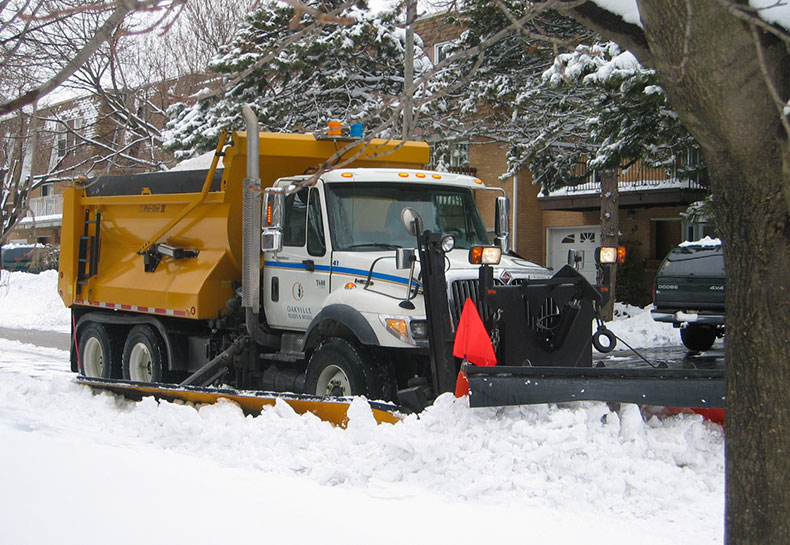
Where our plows start
When it snows, we're ready! This is what our Roads & Works team begins working on:
- Primary and secondary roads are always plowed first to make sure that emergency service vehicles are able to travel throughout the town.
- Residential streets are plowed only after snow accumulates in excess of 7.5 centimetres.
- When all streets require clearing, they are to be completed within 24 hours after the end of the storm.
- When we have a heavy snowfall or back to back snowfall events, it may take longer to clear all the streets.
What are primary, secondary and residential roads?
Primary roads
- Roads with highest speeds
- Roads with greatest volume of traffic
- Examples: Trafalgar and Upper Middle Roads.
Secondary roads
- Roads with less traffic than primary roads, but also have bus routes
- Generally lead to primary roads
- Examples: Glenashton Drive and West Oaks Trails
Residential roads
- Roads with much less traffic than primary or secondary roadways.
- Some seemingly residential roads are classified as secondary due to high traffic volumes, the presence of facilities such as schools, or due to hills and valleys.
Clearing the snow is a big job
When the snow falls, our Roads and Works team maintains 2,000 lane kilometres of roads and 1,100 kilometres of sidewalks, so your understanding and patience is appreciated.
Armed with plows, sand and salt, our crews are ready to clear your roads and sidewalks as quickly and effectively as possible.
In doing our best, it is important to remember that there are some limitations to what can reasonably be done:
Roads and sidewalks won't be cleared to bare pavement
To achieve bare roads and sidewalks, salt must be applied at the onset of snow so that a layer of salt brine is maintained between the road surface and accumulating snow (to prevent bonding).
- To provide this level of service to residential roads, significant increases in equipment and salt would be required, with increased costs and environmental impact.
- Oakville, as well as other Canadian road agencies, are required to have a Salt Management Plan to manage salt use and minimize environmental impacts.
- Aside from Business Improvement Areas (Downtown, Kerr Street, Bronte), sidewalks are only plowed.
Residential roads may develop "snow pack"
"Snow pack" is hard-packed snow on a roadway. It is the condition that can be expected periodically on residential roads.
- Snow pack develops very quickly as vehicles travel on snow-covered roads.
- Snow plows are not able to scrape off snow pack as it is usually bonded to the pavement.
- Although bumpy at times, vehicles typically navigate snow pack quite easily.
- Under snow pack conditions, some rutting can be expected.
- Our Roads & Works team will take steps to improve conditions when warranted.
- It would be unusual for a municipality subject to winter climate conditions, such as Oakville, to consider a snow packed road surface as unacceptable for local residential roads.
Snow plowed from the road may block your driveway
Plow operators do not intentionally block driveways.
- With over 55,000 driveways in Oakville, it is not practical for plow operators to lift their blades at every driveway.
- The plow operator has limited control over the amount and direction of snow that comes off the plow.
When clearing your driveway, try to pile the snow on the right side (standing in your driveway and looking towards the street). This can help reduce the amount of snow that is pushed onto your driveway when a snow plow passes.
The town does not clear driveways.
Sod/lawn damage may occur
Plow operators try to minimize sod damage, but some degree of damage is inevitable.
- Sidewalk plows are required to be large machines in order to effectively plow deep snow, when needed. This makes them less forgiving to operate on sidewalks.
- Deep or drifted snow conditions often completely hide the sidewalk edge.
- When sod is frozen, damage is minimized; however, when sod is not frozen, it lifts away very easily and damage can be extensive.
- Often, the sod removed is overgrowth growing onto the sidewalk.
To report sod damage, please visit the Winter Services report a problem page and this will be added to the list of inspection and repairs for completion by the end of May.
Plowing transit stops
- Transit stops are cleared after snow accumulates;
- in excess of five centimetres (two inches)
- after roads are cleared
- Transit stops on primary and secondary roads are cleared first.
- Transit stop clearing is generally completed within 48 hours after the end of the storm; however, when we have a heavy snowfall, or successive winter events, it will take longer to clear all stops.